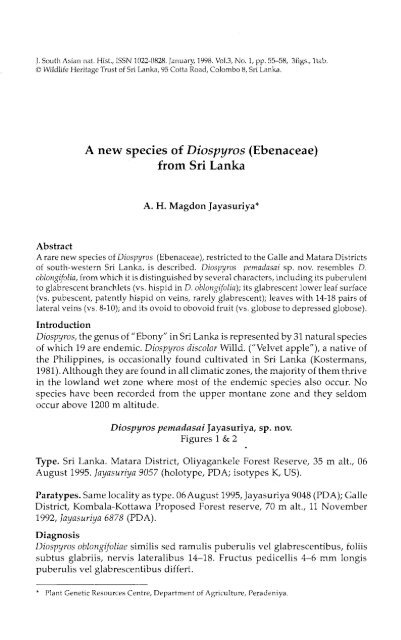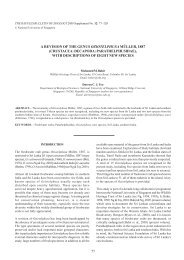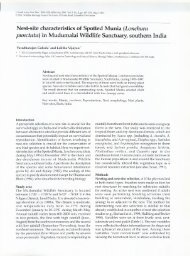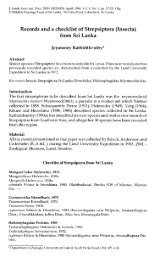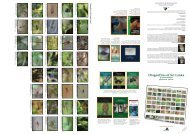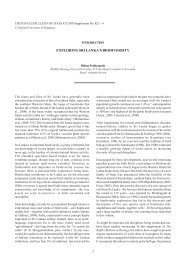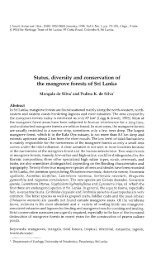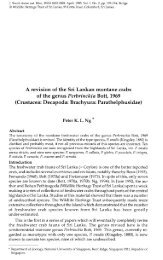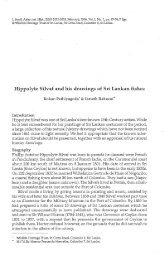A new species of Diospyros (Ebenaceae) from Sri Lanka - WHT
A new species of Diospyros (Ebenaceae) from Sri Lanka - WHT
A new species of Diospyros (Ebenaceae) from Sri Lanka - WHT
You also want an ePaper? Increase the reach of your titles
YUMPU automatically turns print PDFs into web optimized ePapers that Google loves.
J. South Asian nat. Hist., ISSN 1022-0828. January, 1998. Vol.3, No. 1, pp. 55-58, 3figs., ltab.© Wildlife Heritage Trust <strong>of</strong> <strong>Sri</strong> <strong>Lanka</strong>, 95 Cotta Road, Colombo 8, <strong>Sri</strong> <strong>Lanka</strong>.A <strong>new</strong> <strong>species</strong> <strong>of</strong> <strong>Diospyros</strong> (<strong>Ebenaceae</strong>)<strong>from</strong> <strong>Sri</strong> <strong>Lanka</strong>A. H. Magdon Jayasuriya*AbstractA rare <strong>new</strong> <strong>species</strong> <strong>of</strong> <strong>Diospyros</strong> (<strong>Ebenaceae</strong>), restricted to the Galle and Matara Districts<strong>of</strong> south-western <strong>Sri</strong> <strong>Lanka</strong>, is described. <strong>Diospyros</strong> pemadasai sp. nov. resembles D.oblongifolia, <strong>from</strong> which it is distinguished by several characters, including its puberulentto glabrescent branchlets (vs. hispid in D. oblongifolia); its glabrescent lower leaf surface(vs. pubescent, patently hispid on veins, rarely glabrescent); leaves with 14-18 pairs <strong>of</strong>lateral veins (vs. 8-10); and its ovoid to obovoid fruit (vs. globose to depressed globose).Introduction<strong>Diospyros</strong>, the genus <strong>of</strong> "Ebony" in <strong>Sri</strong> <strong>Lanka</strong> is represented by 31 natural <strong>species</strong><strong>of</strong> which 19 are endemic. <strong>Diospyros</strong> discolor Willd. ("Velvet apple"), a native <strong>of</strong>the Philippines, is occasionally found cultivated in <strong>Sri</strong> <strong>Lanka</strong> (Kostermans,1981). Although they are found in all climatic zones, the majority <strong>of</strong> them thrivein the lowland wet zone where most <strong>of</strong> the endemic <strong>species</strong> also occur. No<strong>species</strong> have been recorded <strong>from</strong> the upper montane zone and they seldomoccur above 1200 m altitude.D iospyros pem ad asai Jayasuriya, sp. nov.Figures 1 & 2Type. <strong>Sri</strong> <strong>Lanka</strong>. Matara District, Oliyagankele Forest Reserve, 35 m alt., 06August 1995. Jayasuriya 9057 (holotype, PDA; isotypes K, US).Paratypes. Same locality as type. 06 August 1995, Jayasuriya 9048 (PDA); GalleDistrict, Kombala-Kottawa Proposed Forest reserve, 70 m alt., 11 November1992, Jayasuriya 6878 (PDA).Diagnosis<strong>Diospyros</strong> oblongifoliae similis sed ramulis puberulis vel glabrescentibus, foliissubtus glabriis, nervis lateralibus 14-18. Fructus pedicellis 4-6 mm longispuberulis vel glabrescentibus differt.Plant Genetic Resources Centre, Department <strong>of</strong> Agriculture, Peradeniya.
J a y a s u r iy aFigure 1. <strong>Diospyros</strong> pemadasai Jayasuriya. Habit, fruiting branch with leaves showingupper surfaces except distal leaf, which shows lower surface (drawn <strong>from</strong> Jayasuriya9057).Figure 2. A fruiting specimen <strong>of</strong> <strong>Diospyros</strong> pemadasai Jayasuriya.56 J. South Asian nat. Hist.
A NEW SPECIES OF DlOSPYROSDescriptionTree to 12 m tall and trunk to 30 cm diameter. Bark surface grey. Branchletspuberulent to glabrescent, rusty brown when dry. Leaves coriaceous, oblongovate,9-19 x 4-8 cm (to 29 x 12.5 cm in saplings), rounded to oblique at base,abruptly acute to shortly acuminate at apex, shiny yellowish brown andglabrous on the upper surface, pale yellowish brown and glabrous (except fora few scattered hairs) on the lower surface; veins impressed above and stronglyprominent beneath: lateral veins 14-18 (excluding a few intermediates), stronglydivergent <strong>from</strong> midvein, arcuate at the margin, connected by subscalariformintercostals, areoles relatively large, petiole 8-12 mm long, glabrescent, Flowersunknown. Fruit ovoid to obovoid, fulvous-sericous, interspersed with patenthairs, pedicel 4-7 mm long, puberulent to glabrescent, calyx lobes reflexed,pubescent outside. Seeds (immature) 1.5 cm long.Distribution<strong>Diospyros</strong> pemadasai is confined to the lowland rain forests not very far <strong>from</strong>the coast, in the Galle and Matara Districts, and is rare. It prefers undisturbedhabitats and sporadic trees and saplings <strong>of</strong> this <strong>species</strong> occupy the middle andlower strata <strong>of</strong> the forest pr<strong>of</strong>ile. Ins<strong>of</strong>ar as observed, this <strong>species</strong> is notsympatric with its closest ally, D. oblongifolia (Fig. 3). They differ <strong>from</strong> eachother in the characters shown in Table 1.Table 1. Diagnostic characters <strong>of</strong> <strong>Diospyros</strong> pemadasai and D. oblongifolia.Character D. pem adasai D. oblongifoliaTwig puberulent to glabrescent patently hispidLeafbase rounded to oblique acute to roundedapex abruptly acute to Gradually taperingshortly acuminateinto an acuminate tiplower surface glabrescent pubescent, patentlyhispid on veins,rarely glabrescentcolour when dry yellowish brown reddish brownlateral veins (pairs) 14-18 8-10Petiole 8-10 mm long, glabrescent 2-5 mm long, patentlyhispidFruitShape ovoid to obovoid globose to depressedglobosepedicel 4-6 mm long, puberulent 2-3 mm long, patentlyto glabrescenthispidcalyx lobes hispid patently hispidOccurrencealtitudinal range (m) 50-180 90-500Vol. 3., No. 1. 57
J a y a s u r iy a0-100 I 100-500 500-1000Figure 3. Distribution in <strong>Sri</strong> <strong>Lanka</strong> <strong>of</strong> <strong>Diospyros</strong> oblongifolia (1-11) and D. pemadasai(12-13).EtymologyThe <strong>new</strong> <strong>species</strong> is named in honour <strong>of</strong> Pr<strong>of</strong>essor M. A. Pemadasa* <strong>of</strong> RuhunuUniversity, Matara, <strong>Sri</strong> <strong>Lanka</strong>.AcknowledgementsI wish to thank the Forest Department and the IUCN for enabling me to workon the National Conservation Review Project during which this <strong>species</strong> wasdiscovered. I also thank Dr. W. D. Clayton (Kew Herbarium) for reviewing thispaper and Ms. S. M. Goonatilleke for preparing the illustration.Literature citedKotermans, A.J.G.H. 1981. <strong>Ebenaceae</strong>. Pp 1-54 in: Dassanayake, M.D. & F.R. Fosberg(eds.), A revised handbook to the flora <strong>of</strong> Ceylon, vol. 3. Amerind, New Delhi. 499pp.* Pr<strong>of</strong>essor M. A. Pemadasa died on 10 November, 1997, while this paper was in press.58 J. South Asian nat. Hist.


